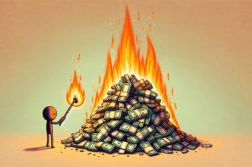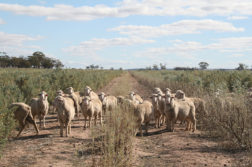The reaction to Monday’s decision by Fair Work Australia to grant a 2.6 per cent boost to the minimum wage was so predictable that The Australian didn’t bother to report it on their front page. It was reserved for the message that NBN, and therefore “Labor”, is to blame for a decision by Telstra's predecessor, the Postmaster-General, to use asbestos in the 1950s and 1960s.
The Australian Chamber of Commerce and Industry (ACCI) called the wage increase a “body blow” to small business “employers”. Its submission to Fair Work Australia had called for a pay rise of only $5.80 on the minimum weekly wage of $606.40.
The Australian Council of Trade Unions (ACTU) called it a “kick in the guts” for low-paid workers. It had argued for a $30 rise, largely on the basis of the need to redress widening income inequality.
It was left to Judith Sloan to make the most contentious comment, suggesting that the minimum wage be frozen – that is, to be allowed to fall in real terms. Hers is an oft-repeated argument: because high wages discourage employers from hiring staff we should let wages fall to the point that there is no more unemployment.
She went on to draw attention to the commission’s observation (pdf) that not only minimum wages, but also the “tax-transfer system plays a significant role in alleviating the impact of earnings inequality and supporting the living standards of low-paid workers”.
Her arguments have superficial appeal. Surely it is cruel to lock people out of the opportunity for work by setting too high a minimum wage. We should let the minimum wage fall and should support living standards through social security payments.
That logic may suffice for a pass mark (but no higher) in a first year economics exam, but it ignores important aspects of the economic role of minimum wages, particularly in the Australian context.
To put it simply, if a business has to pay a reasonable minimum wage, there is an incentive to ensure that people are employed productively. Any Australian visiting the USA, where federal minimum wages are $US7.25 an hour compared with our $A16.37, cannot help noticing how many people are employed in jobs such as parking attendants, domestic servants and supermarket bag packers – “dead-end jobs,” to use John Howard’s term.
In other words, a high minimum wage is a spur to productivity. It carries a financial incentive for efficient work practices, and encourages the use of labour-saving technology. In fact our high exchange rate, while obviously hurting in terms of price competitiveness, should provide an excellent opportunity for businesses to import labour-saving machinery.
In the static world of basic economics textbooks, high wages and substitution of capital for labour may result in some loss of employment opportunities, but in the more complex world of dynamic systems higher productivity means higher incomes and more employment all around — and that’s just what’s been happening in the Australian economy.
Over the last 15 years the number of people employed in high-skill occupations (ABS classifications “managers” “professionals”. “technical and trade workers” and “community and personal service workers”) has grown by 2.3 million or 52 per cent, while the number of people in lesser-skill occupations (“clerical and administrative workers”, sales workers”, “machinery operators and drivers” and “labourers”) has risen by only 0.8 million or 20 per cent. The workforce is changing, a point clearly acknowledged by the commission, when it observed that the proportion of workers described as “award reliant” has fallen from 23 per cent to 16 per cent since 2000, and that non-award incomes were running well ahead of award incomes.
The minimum wage and the associated awards which link to it are becoming more a backstop than a prime determinant of people’s pay and conditions. That doesn’t confine the minimum wage to irrelevance, however. It will always have a function in protecting people who lack the capacity to bargain for their full worth and who may sell themselves short, including those with poor English, those who lack information on comparative wage levels, those whose work situations are isolated and those who lack confidence and negotiating skills.
The minimum wage also serves a stronger function, in that it helps ensure at least a basic income and something more dignified than a low-productivity job. In pure financial terms there is a case for letting the minimum wage fall and supplementing it with social security payments, but that amounts to a subsidy to business to provide dead-end jobs, and it sustains welfare dependence. The message in such an arrangement is “you’re not productive enough to look after yourself”.
Howard regretted the passing of dead-end jobs, and it seems that such thinking is still alive in the Federal Coalition with its opposition to the Gillard Government’s education reforms. The more expansive vision is of a workforce in which everyone is able to make full use of their capabilities. If a high minimum wage restricts opportunities for those without qualifications that’s not necessarily a bad thing, for it provides some incentive for young people to stay on at school and to gain post-secondary qualifications.
It also plays a small part in reducing inequality in the workplace. It provides some protection against the emergence of an “underclass” of working poor resentful of the unfairness of the economic system. It helps ensure that all workers have a stake in productivity and more broadly in sustaining the capitalist system. But the ACCI just doesn’t get this point, for in its submission to the Commission it wrote:
“ACCI anticipates that some parties, particularly unions, will provide submissions which compares the minimum wages with remuneration of company executives of top ASX 200 companies or salaries more generally in the community, including high skilled employees … It is unclear how any of this type of information actually assists the Panel in understanding how determinations of the Panel impacts [sic]on an award reliant small business retailer and their staff?”
The ACCI seems to be locked into an early nineteenth-century model of class struggle, which divides between “bosses” and “workers” with antagonistic interests, where the division of rewards is a zero-sum conflict. Although it describes itself as “the authentic voice of Australian enterprise & industry” it’s more about representing those who see themselves paternalistically as “employers”.
That’s a long way from a more liberal and contemporary economic model in which people – some with financial capital, some with technical skills and qualifications, some with organisational ability, and some with energy and creativity – come together to create value and to share the rewards from their contributions.
Donate To New Matilda
New Matilda is a small, independent media outlet. We survive through reader contributions, and never losing a lawsuit. If you got something from this article, giving something back helps us to continue speaking truth to power. Every little bit counts.



